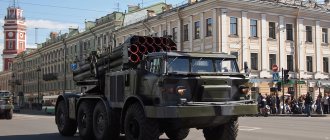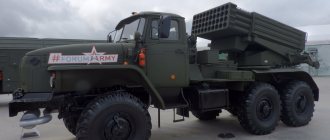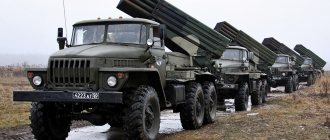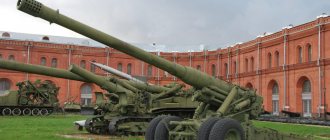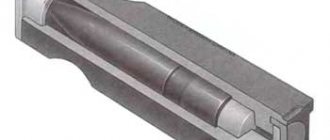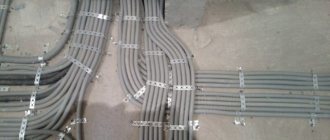Home » Alternative History » Future alternatives » While the cat is sleeping or the latest Chinese MLRS.
Alternatives for the futureWeapons of the future
Kalambur 11/20/2018 1899
9
to Favoritesin Favoritesfrom Favorites 1
Several articles about the latest Chinese MLRS, which we kind of missed.
China has developed the WS-2D MLRS with a firing range of 400 km
MLRS WS-2D
TsAMTO, November 29. The PLA is developing a family of long-range MLRS that will provide artillery units with the ability to hit enemy targets at “strategic” ranges, complementing the niche of short-range ballistic missiles.
The China Precision Engineering Export-Import Corporation (CPMIEC) and Sichuan Aerospace Industries Corporation have developed a new WS-2D MLRS (Wei-Shi/Guardian-2D) with a firing range of 400 km. The installation belongs to the WS-2 family of MLRS, which were adopted by the PLA in 2004.
According to Chinese websites, the weight and size characteristics of the WS-2D are higher than those of the base variant. The length of the rocket is 8.1 m, the diameter is 425 mm, compared to 7.15 m and 400 mm, respectively, for the WS-2. The firing range is 400 km (200 km for the WS-2), which allows this MLRS to be positioned as having the longest firing range in the world.
The WS-2D MLRS is equipped with a guided missile. The missile's circular deflection at maximum range is reported to be less than 600 m. For comparison, the WS-2's CEP is 600 m at a range of 200 km. Like the WS-2, the WS-2D can be equipped with various types of warheads, including a new type of cluster warhead that carries three special UAV/homing projectiles. Sources note that the launcher can carry from 6 to 9 missiles in transport and launch containers.
Information about the WS-2D system allows us to place more confidence in previously published reports about another version of the WS-2 MLRS. In 2007, Chinese sources announced the development of a version of the WS-2C with a firing range of 300 km. According to them, the installation was intended, first of all, to destroy radars, as well as ships and ground objects. The missile was equipped with a passive radar seeker, which was used at the final section of the trajectory.
According to available information, in 2007-2008. a batch of WS-2 MLRS was sold to the Sudanese Armed Forces.
Increased attention to the development of long-range MLRS is evidenced by the demonstration firing of the PHL-03 MLRS, equipped with a package of 12 tubular guides with 300-mm rockets, carried out on July 25 of this year at a training ground located on the coast of the Yellow Sea. The artillery portion of the mount resembles the guide package for the Russian Smerch MLRS, which the PLA reportedly bought in small quantities in the 1990s. The firing range of the PHL-03 MLRS is 130 km.
According to a number of experts, the addition of long-range MLRS to PLA artillery units will help reduce tensions around the deployment of ballistic missile launchers in the Taiwan Strait, without significantly reducing the firepower of the PLA. Currently, Taiwanese sources claim that up to 1,500 Chinese missile launchers are stationed in the area aimed at the island, including short-range ballistic missiles Dongfeng-11 and Dongfeng-15, as well as ground-launched cruise missiles Donghai-10. Considering that the width of the Taiwan Strait ranges from 130 to 220 km, MLRS with a firing range of up to 400 km will be able to partially replace short-range ballistic missile launchers located in the Taiwan area.
More.
Chinese multiple launch rocket systems. Part II
WS family
In the second half of the eighties, the Sichuan Aerospace Industry Company (SCAIC) began developing unguided rockets for multiple launch rocket systems under the general name Weishi (“Defender”). They were supposed to differ from previous missiles in their larger caliber, longer range and greater power. Testing of the first ready-made MLRS of the family, called WS-1, began in 1990.
The basis of the WS-1 complex was the 302 mm caliber rocket of the same name. With a length of about 4.7 meters, the rocket weighed 520-530 kilograms, depending on the type of warhead used. Like all multiple launch rocket systems, the WS-1 was equipped with a solid propellant engine. The engine of the FG-42 model provided a maximum flight speed of about 1300 meters per second. During the flight, the missile rose along a ballistic trajectory to a height of up to 30 kilometers. The firing range ranged from 40 to 100 kilometers. The WS-1 rocket delivered a fragmentation or cluster warhead weighing 150 kg to the target. Stabilization in flight was carried out using four planes at the rear of the rocket. These stabilizers were located at an angle to the axis of the projectile, which led to spinning during flight.
The WS-1 MLRS combat vehicle could be mounted on the base of any suitable three-axle truck. On the frame of the car, immediately behind the standard cabin, an additional compartment was installed to accommodate equipment, and a launcher was installed above the rear axles. The latter was a block of four tubular guides (2x2) installed on a rotary-lifting device. Horizontal guidance was possible within 30° from the vehicle axis in both directions. The maximum elevation angle is 60 degrees. The rotation and lifting of the guides was carried out hydraulically, but if necessary, manually driven mechanisms could be used. The situation was similar with the outriggers that held the vehicle during firing. In the event of a failure of the hydraulic system, the time required to transfer the vehicle from the traveling to the combat position increased significantly. Without any technical problems, a crew of three people should have completed this procedure in 18-20 minutes. The relatively long time it took to transfer to a combat or marching position was determined by the complexity of all actions and the long range, which made it possible not to rush too much with preparations.
However, the longer range came at the cost of some operating and shooting features. Firstly, the WS-1 combat vehicle carried only four unguided missiles, which, when stabilized by rotation, did not provide a highly effective strike in one salvo. Secondly, a separate transport-loading machine was required, with the help of which it took at least five minutes to prepare one projectile for firing. Finally, the need for a massive strike by several batteries was almost not compensated by the large mass of each missile’s warhead. Even with a circular probable deviation of about one percent of the firing range, the dispersion of the projectiles turned out to be too great to effectively hit targets. For these reasons, it was decided to limit ourselves to the experimental operation of several batteries. The WS-1 MLRS was not officially accepted into service.
Already in 1993, a new version of the Weishi family multiple launch rocket system, the WS-1B, appeared. The rocket of the same name received a new engine of greater power, thanks to which the maximum flight speed increased (about 1500 m/s) and, as a result, the maximum range. At the same time, the rocket grew heavier to 705-730 kilograms. The WS-1B MLRS could hit targets at ranges of 80-180 kilometers. In addition, a more powerful engine made it possible to make a new head part. In addition to the standard high-explosive fragmentation and cassette, fragmentation with an increased number of ready-made submunitions appeared. According to unconfirmed reports, a volumetric detonating part was being developed. After modernization, accuracy indicators deteriorated slightly. The CEP now ranged from 1 to 1.25 percent of the firing range. At the same time, the mass of the head part remained the same.
It is quite obvious that the WS-1B MLRS differed from the original WS-1 only in its longer range. There were no other useful innovations, and the accuracy deteriorated. For this reason, the PLA did not accept WS-1B weapons. But these cars attracted the interest of foreign buyers. In the late nineties, Turkey acquired several WS-1 MLRS batteries, which received the local designation Kasigra. A little later, Ankara and Beijing agreed to launch licensed production of WS-1B systems, renamed Jaguar. Other countries showed their interest, but supplies never came.
The latest representative of the Weishi family at the moment is the WS-2 MLRS. Once again, the dimensions of the rocket increased, in particular, the caliber increased to 400 millimeters. The flight range of the new missiles has increased to 200 kilometers. In addition, further developments of the WS-2C and WS-2D, according to available data, involve equipping the missiles with a GPS navigation system, which allows them to fire at targets at distances of 350 and 400 kilometers. There are also rumors about the development of the WS-3 MLRS with even greater firing ranges.
WM family
Soon after the start of production of the Type-83 MLRS, work began on further improving this system. The military wanted to increase the combat characteristics of the existing complex. After analyzing the possibilities, it was decided to return to the wheelbase. The tracked undercarriage had better cross-country ability, but in the case of multiple launch rocket systems they were even excessive. For this reason, the new base for the MLRS, called the WM-80, was the eight-axle special truck Shandong Taian TAS5380SQ.
The selected chassis was initially equipped with a large cabin, which could accommodate even more than the five installation crew. A launcher was placed at the rear of the selected chassis. Its rotating base rotated 20 degrees away from the machine. The elevation angles were adjustable from 20 to 60 degrees. As in the case of the Type 83, small pointing angles in the horizontal plane did not allow firing at low elevation angles - the vehicle’s cabin was in the path of the missiles. A characteristic feature of the WM-80 launcher was the use of transport and launch containers. Before entering the position, the transport-loading vehicle (also on the TAS5380SQ chassis), using its own crane, installed two containers of four missiles each on the launcher of the combat vehicle. This recharging method was chosen due to its relative simplicity and ease of use. The entire process of reloading the combat vehicle took no more than five to seven minutes.
For use on the WM-80, the unguided rockets of the Type 83 complex were modified. The 273-mm ammunition became several tens of kilograms heavier. The weight of the warhead remained the same. At the same time, thanks to the use of a different type of solid fuel, the maximum flight range doubled. The firing range of the WM-80 system is 34-80 kilometers. The rockets for this MLRS marked the first time that Chinese designers tried to give this type of weapon the ability to fire accurately. In addition to simple unguided rockets, an adjustable one was developed. The flight path correction system, according to most sources, worked using satellite navigation systems, but there are references to an inertial system that issues commands to the gas rudders during the initial phase of the flight. Data on the accuracy of the corrected ammunition have not been published. Three warheads were developed for the new 273 mm caliber projectiles: high-explosive fragmentation, cassette and volumetric detonating.
Testing of the new MLRS began in the late nineties. According to available information, the WM-80 multiple launch rocket systems were not adopted by the PLA. However, a certain number of complexes went to third world countries. Interestingly, several combat vehicles were subsequently resold to the United States, where they were carefully studied.
Later, in the 2000s, the WM-80 complex underwent major modifications. The modernization was designated WM-120. First of all, the missile and guidance systems underwent changes. After all the changes, the new rocket with a trajectory correction system was able to fly at a distance of up to 120 kilometers. Automatic guidance control systems have not only been updated, but also changed their composition. The regular composition of the WM-120 MLRS battery included a separate meteorological reconnaissance vehicle equipped with a specialized radar. In addition, all calculations necessary for shooting are now performed fully automatically.
To date, there is no exact data regarding the production and supply of the WM-120 MLRS. There is fragmentary information about negotiations with Chile, Jordan and other third world countries, but there is still no confirmed information. Perhaps the WM-120 project is not yet ready for mass production: despite repeated demonstrations, the new Chinese MLRS has not yet been adopted for service.
A-100
Having not achieved the desired result with the first MLRS of the Weishi family, the Chinese military and engineers began another project. This time they decided to do the same as when creating the Type 81, with the difference that the model for copying was proposed not to be recaptured in battle, but to be bought from third countries. In 1997, several Russian-made 9K58 Smerch complexes were purchased from an unnamed country. All of them were transferred to the CALT research organization for study and development of their own multiple launch rocket system based on them. The creation of a prototype was announced in early 2000.
The combat vehicle of the new A-100 complex looks significantly similar to the original Smerch. Thus, the base for it was the WS-2400 vehicle with an 8x8 wheel arrangement, and the design of the launcher was a slightly modified original unit. Unlike the Soviet/Russian one, the Chinese MLRS has a slightly smaller salvo volume: the launcher is equipped with only ten tubular guides with a U-shaped groove for the initial spin-up of the missile. The caliber of the guides and rockets remained the same as on the Smerch - 300 millimeters. The combat vehicle is held in place during firing by four hydraulic outriggers. The same hydraulic system is used to guide the guide block. All operations are carried out by the MLRS crew from the cockpit. If necessary, the functions of hydraulic cylinders can be performed by manually driven mechanics. After arriving at a position, the combat vehicles of the A-100 complex spend about six minutes moving into a combat position. After striking (the salvo lasts about a minute), within three minutes the vehicles can go to a technical position, where transport-loading vehicles reload them.
For firing, rockets with a course correction system are used. The 840-kilogram ammunition is equipped with a warhead weighing about 235 kg. A relatively powerful solid propellant engine ensures delivery of the load over a distance of 40 to 100 kilometers. The missiles can be equipped with high-explosive fragmentation, incendiary and cluster warheads. Of particular interest is the flight path correction system. It was not without reason that the Chinese took “Smerch” as a basis. The fact is that its high firing range is ensured by a special system designed to keep the missile on the calculated trajectory. This system cannot be called homing, but it provides fairly high accuracy. Naturally, with the correct calculation of the direction to the target and the elevation angle of the launcher. During the first three seconds of flight, the A-100 missile system’s own equipment automatically determines the actual direction of movement, analyzes it and compares it with the calculated trajectory. If necessary, commands are issued to the gas rudders, which allows the ammunition to be brought to the right direction. After this correction, the control system does not interfere with the flight, except in cases where the missile is equipped with a cluster warhead. When such warheads are used, the control system at the calculated time issues a command to open the cassette and eject submunitions. The stated deviation from the target is no more than 0.5% of the range to the target.
A separate fire control complex is responsible for guidance accuracy. Each battery is assigned one vehicle with such equipment. The tasks of the control vehicle include determining the coordinates of the battery's combat vehicles, generating guidance information and transmitting it to the missile control systems. The last stage of preparation for a salvo is carried out “through the mediation” of the on-board equipment of the combat vehicles themselves. All pre-launch procedures related to the creation of a missile flight program take no more than one and a half minutes after arrival at the position.
In 2002, the A-100 system was adopted by the Chinese army. The total number of complexes produced is small - no more than a hundred. Low production volumes are due, first of all, to the great complexity of production and the cost of both combat vehicles and missiles. In addition, the A-100, with its long firing range, is in some way a special weapon designed to perform special tasks.
AR1A
In 2009, at the IDEX exhibition, NORINCO presented its new development, apparently created in the mid-2000s. The AR1A MLRS is a further development of the A-100 project. It is noteworthy that this time the Chinese did not take advantage of other people's experience by purchasing and studying ready-made equipment. NORINCO employees completely legally and officially collaborated with the Russian State Research and Production Enterprise Splav, the leading Russian enterprise for the development of multiple launch rocket systems.
At the moment, the AR1A MLRS represents the best achievements of Chinese engineers put together. The combat vehicle uses a launcher similar to the unit of the WM family of systems: two separate containers for five missiles each are installed on its lifting boom. It is noteworthy that to facilitate the construction of the containers, they are made as a frame frame with tubular guides installed inside. To increase accuracy, the launcher has rotating devices that allow you to direct the guides with an error of the order of one thousandth (about 0.06°). In addition to the launcher, the combat vehicle has a cabin for all four crew members and equipment. The latter allows you to collect and process the vast majority of necessary information. Thanks to the correct selection of equipment, the combat vehicle of the AR1A complex has the ability to operate independently.
It is worth noting that an independent attack is still a “just in case” remedy. The main method of striking is to work as a battery or division. In addition to vehicles with a launcher, the formation includes command-staff and transport-loading vehicles, as well as a separate vehicle with a radar station designed to collect data on the weather situation.
The 300mm rockets were made in accordance with the new views of the Chinese military on the appearance of these ammunition. Different missile warheads imply not only different effects on the target, but also different characteristics. At the moment, the range of shells is as follows: - BRE2. A guided projectile with a firing range of 60 to 130 kilometers. The high-explosive fragmentation warhead weighs 180 kilograms and hits targets within a radius of at least one hundred meters; - BRE3. Corrected projectile of shorter range. Shooting is possible at a distance of 20 to 70 kilometers. The 200-kilogram cluster warhead is equipped with 623 cumulative fragmentation submunitions. Combat elements are dispersed over a radius of up to 160 meters and penetrate up to 50 millimeters of homogeneous armor; - BRE4. A missile with a cluster warhead and a longer range: 60-130 kilometers. It is equipped with combat elements similar to BRE3 submunitions, but in smaller quantities - 480 pieces.
To date, only a few AR1A complexes have been produced and are being tested. The military of different countries have repeatedly been interested in this multiple launch rocket system, but it is not yet offered for export. As for supplies for the Chinese army, they should be expected over the next few years.
Based on materials from the sites: https://rbase.new-factoria.ru/ https://military-informer.narod.ru/ https://sinodefence.com/ https://articles.janes.com/ https:// military-today.com/
China promotes new WS-3 MLRS
MLRS WS-3
The Chinese company has begun implementing a marketing program to promote the new WS-3 MLRS, equipped with six 400-mm rockets, to the world market, reports TsAMTO.
Externally, the WS-3 launchers are very similar to the previously developed WS-2 MLRS, but are equipped with new missiles, reports Jane's Defense Weekly.
The firing range remained the same – 70-200 km. At the same time, the accuracy of missile fire has increased significantly. The circular probabilistic deviation (CPD) of the new ammunition, equipped in the basic version with an inertial navigation system, at the maximum firing range is 300 m. When the missile is equipped with a combined GPS/inertial navigation system, the CEP at a firing range of 200 km is about 50 m.
The length of the rocket is 7.15 m, diameter is 400 mm. It is equipped with four stabilizers in the tail and four control planes in the nose. The missile can be equipped with various warheads weighing up to 200 kg, including high-explosive, cluster with 540 small-caliber submunitions, and volumetric explosion.
The launcher is equipped with three transport and launch containers, each of which contains 2 missiles. The artillery unit is mounted on the platform of a front-wheel drive all-terrain truck TA5450 with an 8x8 wheel arrangement. The machine is equipped with a four-door fully protected cab with air conditioning system.
Hydraulic stabilizers located between the first, second, third and fourth wheels on both sides of the launcher ensure platform stability when firing.
According to Poly Technologies, deployment time to a firing position is about 12 minutes. According to available information, the development of the system was carried out by the Sichuan Aerospace Industries Corporation. Marketing and sales of MLRS WS-2 and WS-3 are carried out by Poly Technologies.
And further.
MLRS
WS 1 1
WS-1 is a Chinese 302 mm multiple launch rocket system. Designed to strike critical targets located deep in enemy defenses, including military bases, troop concentration areas, missile launchers, airports and transport hubs, administrative and industrial centers.
MLRS WS-1B (WeiShi-1B) was developed by the Sichuan Aerospace Industry Corporation (SCAIC, Chengdu) and is the result of a modernization of the WS-1 multiple launch rocket system. The development of systems of the WeiShi family began in the 80s of the last century; in 1990, the first MLRS of this family, WS-1, entered testing. In 1993 The upgraded WS-1B system with increased firing range and combat effectiveness was demonstrated for the first time. The systems were not adopted by the Chinese People's Liberation Army (PLA).
The WS-1B is currently offered in international markets by the China National Precision Machinery Corporation (CPMIEC).
In 1996 A Turkish-Chinese contract worth $150 million was signed for the supply of WS-1 MLRS. In accordance with this agreement, CPMIEC supplied a WS-1 MLRS battery (5 combat vehicles) to the Turkish armed forces in 1997 and provided technical assistance in organizing the independent production of 5 more modernized batteries. These systems, designated "Kasirga", are in service with the Turkish army. Subsequently, licensed production of the WS-1B MLRS was organized under the designation “Jaguar”.
At the international aviation and astronautics exhibition "Airshow China 2004" (Zhuhai), SCAIC presented the latest model of the WeiShi family - WS-2 with a range increased to 200 km, and missiles equipped with a trajectory correction system.
The launcher is a package of 4 cylindrical guides in a cross-shaped configuration, mounted on a modified Tiema XC2200 6x6 truck chassis. The machine is equipped with a hydraulic system, with the help of which the guidance drives of the guide package and jacks are driven. Manual duplication of guidance drives is provided. Guidance of the guide package is provided vertically at an angle from 0 to 60° at a speed of up to 3 degrees per second and azimuthally from -30° to +30° from the longitudinal axis of the launcher at a speed of up to 4 degrees per second. The time it takes to transfer the launcher from traveling to firing position is about 20 minutes. Crew - 3 people.
WS 1 2
The developers also offer the option of placing a package of 6 guides on a car chassis with an 8*8 wheel arrangement.
The DZ-88B command post is equipped with communications equipment for data and voice communications, a GPS system, a set of meteorological equipment, a gyro-orientation system and IR night vision devices. The DZ-88B command post is equipped with a modern digital fire control system, a system for monitoring and testing equipment, as well as training personnel. Crew - 5 people.
The WS-1 unguided rocket is equipped with a solid-propellant single-mode FG-42 engine and has a maximum flight speed of up to 4.2M, a maximum trajectory altitude of 30 km, a minimum firing range of 20-30 km and a maximum range of up to 100 km. Flight time at maximum range is 170s. The circular probable deviation is about 1% of the range. NURS WS-1 has a weight of 524 kg, the weight of the warhead is 150 kg. In flight, the projectile is stabilized by firmly fastened blades of the stabilizer block, installed at an angle to the longitudinal axis of the NURS to ensure rotational motion at a given speed.
NURS WS-1B is equipped with an upgraded single-mode FG-43 engine with a solid fuel charge based on a copolymer of polybutadiene with hydroxyl end groups (Hydroxy Terminated Polybutadine). The FG-43 engine has a maximum thrust of 275 kN, fuel charge weight - 370 kg, operating time - 5.3 s. For the WS-1B NURS, the following have been developed: a general-purpose high-explosive fragmentation warhead ZDB-2 and a cluster warhead SZB-1 for destroying accumulations of equipment, infantry fighting vehicles and other lightly armored targets. The ZDB-2 warhead is equipped with an explosive charge weighing 70 kg, 26,000 ready-made submunitions and provides a destruction radius of up to 70 m. The SZB-1 cassette is equipped with 466 cumulative fragmentation combat elements with 70 mm armor penetration. The maximum projectile flight speed reaches 5M, the trajectory height is 60km, the minimum firing range is 80km, the maximum is up to 180km. Circular probable deviation is 1-1.25%. Starting weight - 708 kg, weight - 150 kg. There is information about the development of a volumetric detonating warhead.
The WS-1B MLRS battery includes a DZ-88B command post, 6-9 HF-4 launchers and the same number of QY-88B transport-loading vehicles with 20 rounds of ammunition each.
WS 1 3
Characteristics:
- Caliber: 302 mm;
- Projectile length: 4.7 m;
- Projectile weight: 524 kg;
- Warhead: 150 kg;
- Firing range: WS-1 40-100 km, WS-1B 60-180 km;
- Projectile speed: WS-1 Mach 4.2, WS-1B Mach 5.2;
- Number of guides 4.
400-mm MLRS WS-2 (other designation SY-400).
MLRS SY-400
Developed by China Precision Machinery Import and Export Corporation, with the assistance of the Chinese Academy of Launch Vehicle Technology Research. Work on the MLRS is at the stage of readiness for mass production, although there is evidence that several vehicles were sold to Sudan. The MLRS was first demonstrated in November 2008 at the 7th China International Aerospace Exhibition in Zhuhai.
In fact, the WS-2 is no longer an ordinary, standard MLRS, but a so-called “MLRS with guided munitions” or GMLRS (Guided Multiple Launch System). Four types of warheads have been developed for the RS: cassette with 560 or 660 anti-tank warheads; high-explosive fragmentation with pre-prepared damaging elements - steel balls; high-explosive high-power; volumetric explosion. And the Chinese military already has such “smart” missiles, while in Russia they are just being created - within the framework of the mentioned “Tornado-S” project
Well, for dessert.
Chinese clones of Smerch are used in Ethiopia
Rebels from the Tigray People's Liberation Front group used Chinese AR-2 multiple launch rocket systems during the fighting. Fire from the installations is carried out not only on the territory controlled by the Ethiopian government forces, but also on cities in neighboring Eritrea.
The Chinese AR-2 MLRS, which is essentially a modified version of the Russian Smerch, was used for the first time in combat. During the civil war that broke out in Ethiopia, rebels from the Tigray People's Liberation Front (TPLF) group used these installations to shell areas controlled by government troops. It is known that on the night of November 14 they shelled the cities of Gondar and Bahir Dar, located in the state of Ahmara. It is known that there was destruction as a result of the shelling; no information was received about the dead or wounded.
In addition, the rebels are attacking neighboring Eritrea. In particular, on November 15, its capital, the city of Asmara, came under fire. The results of the attacks have not been reported. The TPLF group has been an old enemy of the Eritrean authorities since the 1998-2000 war between Ethiopia and Eritrea, when the leaders of the current rebels stood at the head of the Ethiopian state.
The 300-mm AR2 MLRS was developed by the Chinese company NORINCO based on the A-100 system (actually a copy of the Russian 9A52 Smerch MLRS) in 2004. The combat vehicle is made on the chassis of a WS-2400 vehicle with an 8x8 wheel arrangement. The artillery piece includes a package of 12 tubular guides. The crew of the combat vehicle consists of four people. The combat weight of the MLRS is 42 tons, the maximum speed is 60 km/h, and the fuel range is 650 km. For stability when firing, the MLRS is equipped with four hydraulic supports. The ammunition kit includes three types of unguided RS: BRE2, BRC3 and BRC4. The BRC4 RS with a cluster warhead consisting of 414 cumulative fragmentation submunitions, and the BRE2 with a high-explosive warhead weighing 190 kg, make it possible to hit targets at ranges from 60 to 130 km. The guided 300-mm BRE3 RS is equipped with an inertial/GPS navigation system and provides highly accurate target engagement at the same ranges. The combat vehicle is loaded using a TZM on a similar chassis equipped with a hydraulic lifting device and a rammer.
AR-2 MLRS were purchased by Ethiopia from China in 2007. At that time, the TPLF group was at the head of the country, and therefore it is not surprising that vehicles of this type ended up in the armed forces controlled by it.
Let us recall that on November 3, rebels from the Tigray People's Liberation Front group attacked Ethiopian government troops in the north of the country. In response to this, the President of the Ethiopian state, Abiy Ahmed Ali, launched a military operation against the armed forces of the TPLF.
The characteristics of the machine are provided by TsAMTO.
If you find an error, please select a piece of text and press Ctrl+Enter.
China's MLRS are more powerful than those of the US and Russia
The People's Liberation Army of China said that its multiple launch rocket systems (MLRS), capable of hitting targets at a distance of up to 150 kilometers, significantly exceed the degree of automation and firepower of similar Russian and American-made systems and can cover enemy positions with a real “barrage of fire and metal."
“The firepower of each launcher in my battalion is equal to an entire battalion equipped with conventional artillery pieces,” said the commander of the missile and artillery battalion, Wang.
“More specifically, each missile can cover a huge area the size of several football fields, while each launcher can fire more than 10 missiles within a few minutes,” the state-run China Daily quoted the political officer as saying.
“In addition, as a result of hard training, we can boast the same high accuracy of fire as surface-to-surface missiles.” This means that no enemy can withstand our attacks,” Wang said.
This long-range MLRS system was first shown to the public during a military parade in Beijing in Tiananmen Square in 2009.
The weapon was presented as an effective complement to the strike weapons in the PLA arsenal, which include tactical missiles and conventional artillery systems. According to the battalion command, the system has a maximum firing range of 150 km.
For comparison, the Russian BM-30 Smerch MLRS system has a maximum firing range of 90 km, and the American M270 system has a maximum firing range of about 70 km, China Daily reports.
Brigade commander Colonel Yang Guobin said: “Compared with the multiple launch rocket systems used by foreign armies, ours is better in terms of automation, computerization and firepower. It is fair to say that this weapon is the PLA ground forces' most powerful tactical deterrent weapon."
When the battalion received the MLRS system instead of traditional artillery systems in 2009, the new weapon seemed so complex that the personnel had to learn from scratch.
To effectively employ these weapons in various combat situations, such as in coastal areas, plateaus or mountainous areas, the battalion has developed 12 combat plans as well as several firing position diagrams, the brigade commander said.
